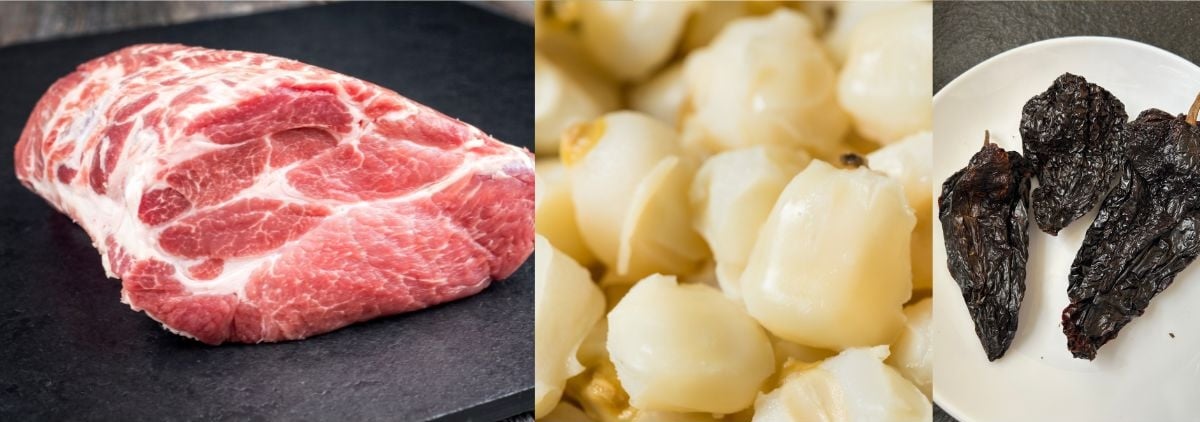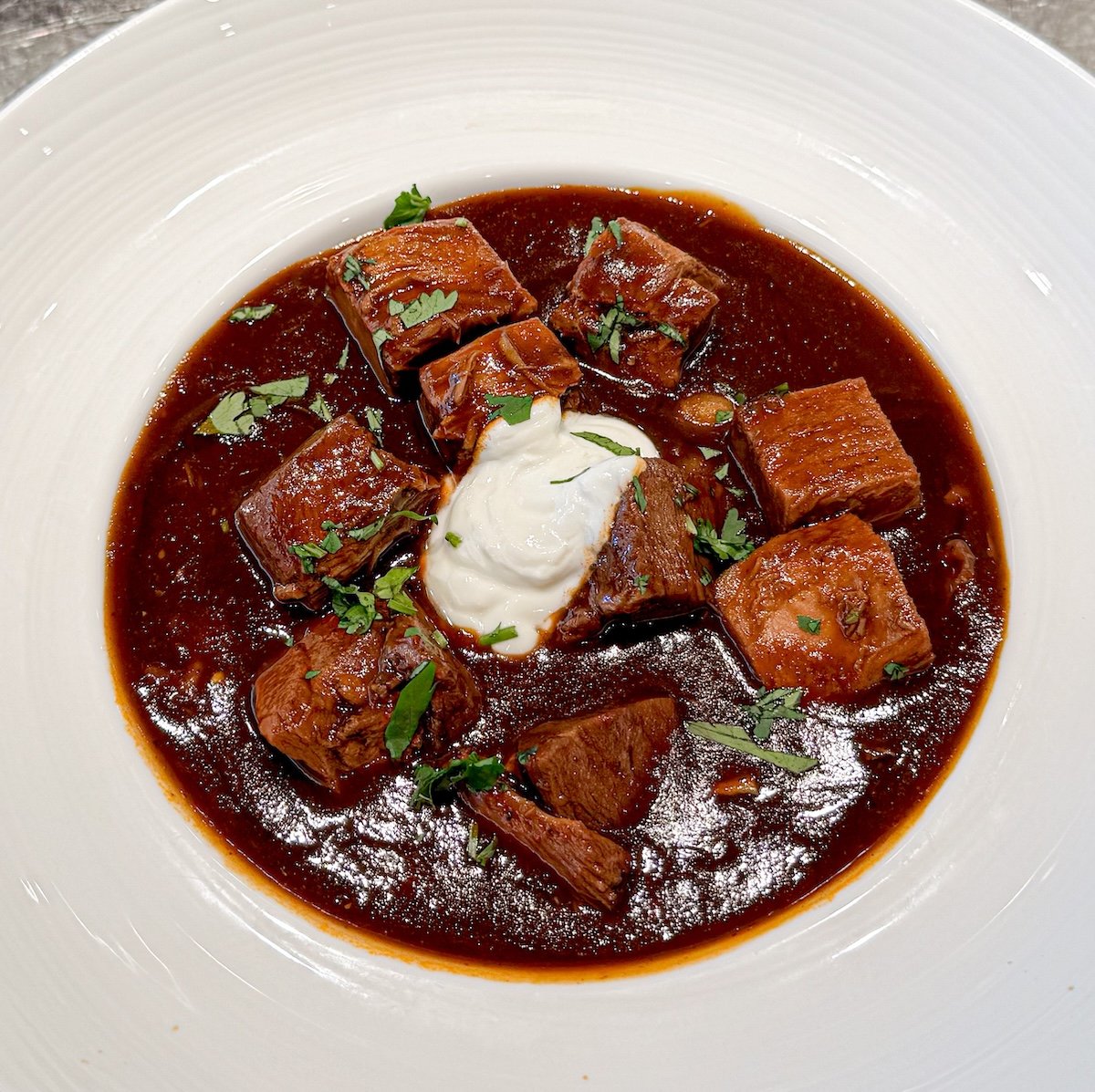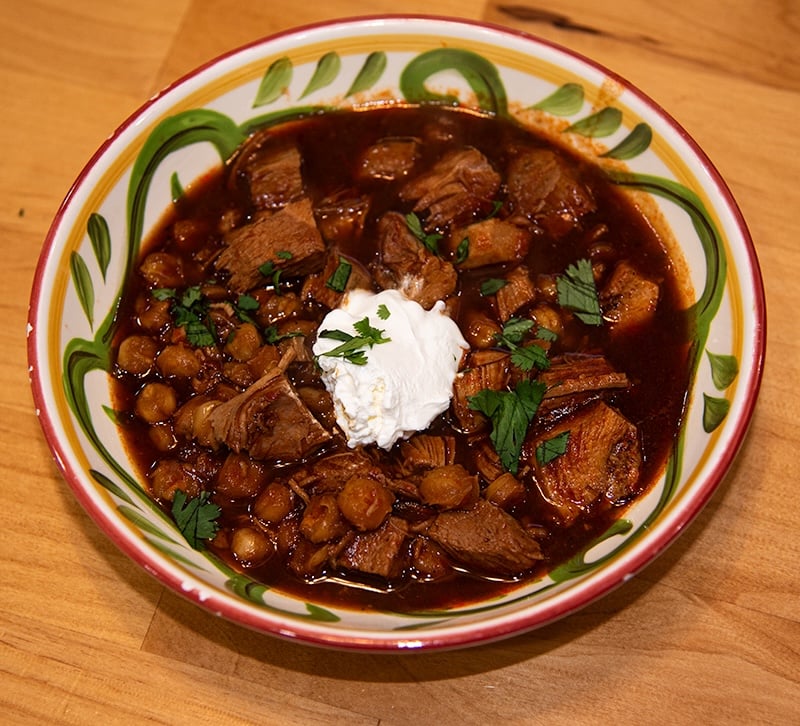In this recipe, the classic Mexican stew, pozole rojo, is made super-juicy and a little smoky with the science of sous vide que.
If you’re looking for a stick-to-your-ribs meal, you can’t do much better than Mexican pozole. It’s full of deep flavors, feeds a crowd, and is pretty easy to make. The one caveat: pork can get dry. A little science helps keep it juicy.
What is Pozole Rojo?
Pozole and its many variations are among the most beloved dishes in Mexico, close to a national dish. The unifying factor among them all is corn. The Indigenous American word pozolli refers to a type of corn. One variation, pozole rojo (pronounced puh-SO-lay RO-ho), is a flavorful pork stew enriched with hominy and imbued with dried red chiles, and every home cook has his or her unique twist. Some make it hot, some not. Either way, pozole rojo has the same problem that all stews have. You can actually dry out meat by cooking it in liquid!
Stew science
In all cooking, heat causes muscle fibers to contract and squeeze out water. For details, check out my article on meat science. The same process happens whether the meat is submerged in liquid or heated it in an oven or on a grill. Once out, the liquid cannot get back into the fibers. So proper stewing is tricky. You need to keep the temperature low and avoid cooking the meat longer than necessary. Normally, a low simmer is the way to go, but sous vide is even better.
Up your game: Join our Pitmaster Club. Try it out for free for 30 days. No credit card is needed. No spam. Join now and Be Amazing!
What is Sous Vide Que?
Sous vide (pronounced soo-VEED) is a type of cooking barbecue fans are familiar with: low and slow. Sous vide means “under vacuum” in French. You put food in a bag, suck out the air (creating a vacuum), then immerse the bag in water at a set temperature. The beauty of this method is that the food’s internal temperature can never rise above the water’s temperature, so you can hold something like pork shoulder at 140°F for hours—days even—and it will never overcook.
The ”Que” part comes in with your smoker or grill. In this recipe, I sous vide bagged pork shoulder in a water bath for 12 hours and then smoke it a low temp for 30 minutes to get some smoke flavor into the meat. After that, the pork is mixed into the stew to briefly heat it. The juices stay in the meat and the pozole rojo has a wonderful smoke aroma. For details on this technique, check out our article on sous vide que.
For a more comprehensive deep dive into the subject, consider purchasing our eBook “Sous Vide Que Made Easy: How To Deliciously Marry Sous Vide with The Grill And Smoker“. It is only $3.99 on Amazon in Kindle format. To enjoy the book, you will need the Kindle app which runs on iOS, MacOS, Android, PC, and Kindle.
Why this recipe works
- Classic flavors. The combination of pork shoulder and ancho chile peppers give this stew deep, comforting flavors. Some brown sugar balances the savoriness with a touch of sweet.
- Improved juiciness. Stews can dry out when simmered for too long. The sous vide method ensures that the pork in this pozole rojo stays ultra-juicy.
- A touch of smoke. 30 minutes on your smoker a low temperature brings wonderful smoky aromas to stew, blending perfectly with the taste of dried ancho chiles.

Ingredients & Substitutions
- Pork butt (shoulder) is the base of the stew. Why is pork shoulder called pork butt? Click here to find out. It’s a tough cut that’s full of flavor, perfect for low and slow cooking. Pork butts can run 5 to 10 pounds. If you have a big one, you can cut it down to size. Or double the recipe. Or cook and smoke the entire pork butt but only use the amount called for in the stew, and then freeze the extras to make pulled pork sandwiches.
- Hominy is made from dried corn kernels that is then soaked in a dilute solution of lye. This removes the hull and germ and helps the kernels release more of their nutrients. It is then rinsed and roasted. It can be ground to make grits or masa, the dough used to make tortillas. Canned hominy, which is what’s called for here, can be found in the Mexican aisle of most well-stocked supermarkets.
- Ancho chile peppers are dried red poblano peppers. They have very little heat. Nothing to fear. And they’re cheap. Look for them in bags in the produce section of your supermarket, or in the Mexican aisle. They have a deliciously dark, almost raisin-like flavor. Find out how hot are ancho chile peppers here.
- Red bell peppers, red onions, garlic, cumin, and bay leaf provide the aromatic base for the stew. No wonder they’re called aromatics.
- Pork stock brings savory flavor and most of the liquid to the pozole. While pork stock marries best with the pork shoulder, chicken stock or vegetable stock work fine as substitutes. If you’re curious, read more about the science of stock.
- Light brown sugar is the surprise ingredient. Pork loves sugar, especially brown sugar, and a little brown sugar in this stew balances all of the savory flavors from the pork, the smoke, and the aromatics.
How to make Pozole Rojo
Step 1: Cook the pork. You’ll want to do this step at least a day ahead. It takes hardly any of your active time, but the pork needs to sit in the sous vide bath by itself for 12 hours or overnight. Easy peasy.
Step 2: Smoke the pork. We’re keeping the heat low here to retain all those flavorful juices in the pork. Get your smoker or grill stabilized at a temperature somewhere between 175° and 200°F. Then put the sous-vided pork on the smoker and let it sit for about 30 minutes.
Step 3: Make the stew base. Here’s where the magic happens. You remove the stems and seeds from the dried ancho chiles and then toast the chiles in a hot pan, no oil. Toasting chiles adds tons of flavor. Then you add the aromatics to the pot—no sauteing—along with the stock and simmer together for about an hour. Then you puree it. That creates a nice thick, flavorful stew base to buoy the chunks of pork.
Step 4: Simmer to finish. Add the hominy and let it simmer on low for another hour or so. Then there’s just one thing left to do. Add the pork, let it reheat briefly in the stew, and serve.

Expert tips
Make it ahead: All stews tastes best when reheated anyway. This one can be made in stages to simplify things. You can sous vide the pork butt a day ahead, or even several days ahead, and keep it refrigerated. You can also smoke it several days ahead and keep it chilled. After simmering the stew base with the simmering hominy, it can be refrigerated for a few days or frozen for a month or so. Then just thaw, heat through with the pork, and serve.
Garnish at will: Like many stews, pozole rojo is open to interpretation. Garnish it with sliced radishes, chopped onion or avocado, or even crispy chicharróns.
Recipe FAQs
Pork, hominy, and red chiles are the keys. The rojo (red) color comes from the chiles.
Ancho chiles (dried poblano peppers) are traditional. Guajillo chiles (dried mirasol peppers) are sometimes used as well. A blend of chiles gives the stew a more complex flavor.
The chiles, pork, aromatics and stock give pozole rojo a rich, deep, savory flavor with a hint of sweetness from the hominy. It’s not super spicy, but you can make it spicy if you like. This version tastes a little smoky because I briefly smoke the pork. Cumin and bay leaf round out the aromas. I like to garnish the stew with sour cream, cilantro, and a squeeze of lime.
If you like this recipe, you’ll love…
- Chicken Tortilla Soup
- Brunswick Stew
- Smoked Sous Vide Que Pork Loin
- Homemade Chili
- Chili Verde with Smoked Pork Butt
- Sous Vide Que Made Easy
Makes:
Takes:
Equipment
- Sous vide immersion circulator
- resealable plastic bags or sous vide bags
- food processor or blender
Ingredients
- 2 pounds boneless pork butt (shoulder)
- 1 medium-size ancho chile
- 1 medium red onion
- 2 medium cloves garlic
- 1 medium sweet red bell pepper
- 1/4 cup light brown sugar
- 2 quarts low-sodium pork stock or chicken stock or vegetable stock
- 1/2 teaspoon ground cumin
- 1 dried bay leaf
- 1 (15-ounce) can white hominy
- Morton Kosher Salt to taste
- Hot sauce to taste
Garnishes
- 1 cup sour cream
- 5 teaspoons finely chopped cilantro and/or parsley
- 10 lime wedges
These recipes were created in US Customary measurements and the conversion to metric is being done by calculations. They should be accurate, but it is possible there could be an error. If you find one, please let us know in the comments at the bottom of the page
Method
- Sous vide the pork butt. 24 hours before serving, trim all surface fat off the butt. If it has a bone, remove it, and cut apart 2 pounds of boneless meat. Trim off any more excess fat. Salt the meat with 1/2 teaspoon Kosher salt per pound. Bag it in a sous vide bag and sous vide at 140°F for 12 hours. When it is done, cut a tip off the bag and drain the liquid and refrigerate for later.
- Smoke it. Fire up your smoker or, if you have real good temperature control, your grill. Aim to keep the cooker between 175° and 200°F. Remove the meat from the bag, leave it wet, and smoke it for 30 minutes at that low temperature. Keep the liquid in the bag refrigerated. Once smoked, refrigerate the meat in a separate bag.
- Simmer. Heat a 2-quart pot. Remove the stems and seeds from the anchos and break them into 1-inch chunks. Toast the chiles over medium-low heat in the pot for about 3 minutes, no oil, flipping often. Cut the stem off the onions, peel them, and coarsely chop. Peel and coarsely chop the garlic. Remove the stem and seeds from the sweet bell pepper and coarsely chop it. Put the chicken stock, the liquid from the sous vide bags, the onion, garlic, bell pepper, bay leaf, and cumin in the pot. If you are using a pig's foot, add it now. Simmer about 1 hour.
- Blend. Let the stock cool for about 30 minutes, then blend it until smooth in a food processor or blender. Pour it back into the pot. Drain and rinse the hominy, add it to the pot, and simmer for 1 hour. At this point, the stew can be made ahead and refrigerated in an airtight container for 2 to 3 days or frozen for weeks.
- Warm up the butt. Chop the pork butt into 1-inch cubes and be careful to remove concentrations of fat. Add the pork to the warm stock and heat for only about 15 minutes before serving, just enough to warm them but not enough to dry them out. Taste and add hot sauce to your tolerance level and salt if needed.
- Serve. Choose your garnishes and chop, slice, and dice. Remember that avocado browns quickly, so don’t cut it open until just before serving. Ladle into bowls and serve. You can add toppings before serving or just set toppings on the table, and let your guests select.



High quality websites are expensive to run. If you help us, we’ll pay you back bigtime with an ad-free experience and a lot of freebies!
Millions come to AmazingRibs.com every month for high quality tested recipes, tips on technique, science, mythbusting, product reviews, and inspiration. But it is expensive to run a website with more than 2,000 pages and we don’t have a big corporate partner to subsidize us.
Our most important source of sustenance is people who join our Pitmaster Club. But please don’t think of it as a donation. Members get MANY great benefits. We block all third-party ads, we give members free ebooks, magazines, interviews, webinars, more recipes, a monthly sweepstakes with prizes worth up to $2,000, discounts on products, and best of all a community of like-minded cooks free of flame wars. Click below to see all the benefits, take a free 30 day trial, and help keep this site alive.
Post comments and questions below
1) Please try the search box at the top of every page before you ask for help.
2) Try to post your question to the appropriate page.
3) Tell us everything we need to know to help such as the type of cooker and thermometer. Dial thermometers are often off by as much as 50°F so if you are not using a good digital thermometer we probably can’t help you with time and temp questions. Please read this article about thermometers.
4) If you are a member of the Pitmaster Club, your comments login is probably different.
5) Posts with links in them may not appear immediately.
Moderators